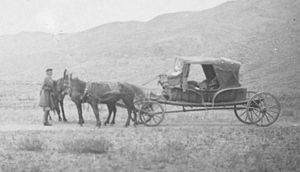
Summary
The tarantass is a four-wheeled horse-drawn vehicle on a long longitudinal frame, reducing road jolting on long-distance travel. It was widely used in Russia in the first half of the 19th century. It generally carried four passengers. The origin of the word is not known: Max Vasmer's Etymological Dictionary of the Russian Language[1] lists a number of variants from regional dialects to the ancient Indo-European roots with the mark "doubtful".

Description edit
Vladimir Sollogub and Alexandre Dumas gave ironic descriptions of a tarantass that may be summarized as follows. The tarantass has been described as two long poles serving as parallel axles supporting a large basket forming a cup or bowl. It is not suspended on springs, and generally has no benches. The vehicle is accessed by an external ladder. The interior is generally covered by straw, changed at intervals for cleanliness, upon which the passengers rest.[2][3][4]
Existing photographs of tarantasses generally convey the fact of its wheels being exclusively wooden constructions, but it is evidenced that at least on occasion, the tarantass would be rubber-wheeled, requiring inflation, like modern tyres. In Dostoyevsky's The Village of Stepanchikovo, at one point the narrator describes "a tyre that had burst on one of the front wheels of [the] tarantass".[5]
The types of a tarantass manufactured in early Soviet Union varied. [6]
In popular culture edit
In 1840, author Vladimir Sollogub published a satirical novelette "Tarantass". The main hero of the story drove a team of three horses.
An article in a Melbourne Australia newspaper dated 30/9/1887 refers to a journey by the Hon. James Campbell of a drive of 1800 miles by tarantass from Vladivostok to Moscow.[citation needed] [The distance from Vladivostok to Moscow is nearly 9000km, or over 5000 miles, so there is something wrong with this story.]
In 1893, medical doctor and Christian missionary Charles Wenyon travelled from Vladivostok to the Urals, to the marker on the boundary of Europe and Asia by a combination of tarantass and river steamer. He claimed to be one of the last Englishmen to take this route "in the old fashioned way", by steamboat (up the Ussuri and Amur), tarantas (across the expanses of Siberia), and rail (at the last stretch along the newly-constructed railroad branch from Europe, across the Ural River into Siberia). His journey is described in Four Thousand Miles Across Siberia: On the Great Post-Road.[7] He described tarantas as "a sort of means of transport which combines the disadvantages of all the others".
References edit
- ^ Макс Фасмер. The etymological dictionary of Russian. Translation from German and additions of member-correspondent АН the USSR O.N.Trubacheva. In four volumes. М.: Progress, 1986
- ^ Соллогуб Владимир Александрович, Тарантас
- ^ Дюма А. Путевые впечатления в России. М.: Ладомир, 1993.
- ^ Smith, D.J.M. (1988). A Dictionary of Horse Drawn Vehicles. J. A. Allen & Co. Ltd. p. 159. ISBN 0851314686. OL 11597864M.
Tarantass. Punt-shaped Russian passenger vehicle. Suspended on a series of flexible poles between fore and hind carriages. The rearward part, with a cross-bench for three or more passengers, was protected by hood and apron. Driven to a troika or team of three horses abreast.
- ^ Dostoyevsky, Fyodor (1859). The Village of Stepanchikovo.
- ^ Музей торговли — Товарный словарь — Тарантас
- ^ Anthony Cross, In the Lands of the Romanovs p. 47, 304
External links edit
- http://www.thefreedictionary.com/Tarantass


